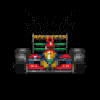PlatinumZealot wrote: ↑29 Feb 2024, 01:16
Farnborough wrote: ↑28 Feb 2024, 11:36
PlatinumZealot wrote: ↑28 Feb 2024, 02:54
Good find.
The kinematics of it, is to put it on or as close to the king pin axis for the least "bump steer" effect.
Is that known as "bump steer" ?
My understanding of that description classically denotes the steering rack ends proscribing a difference in arc to the one in which the upright is notionally completing.
Hence the steered wheels accumulate more toe in or out as the suspension travels from full droop to full bump. The chassis effectively giving directional shift with the wheel held still throughout that compression event.
Mounting the push-rod at a difference to upright axis SHOULD give rise or drop to suspension height through turning the steering, but not alter toe etc.
Castor and akerman would then be in their purest implementation to alter those effects without being "poluted" by an unquantified overlay and amount of pure "bump" steer.
It will have on effect on the steering becuase it produces a torque around the kin pin axis if it is offset to the axis. The driver will feel it in the steering. In Formula 1 the travel is not great, so that maybe whey they can get away with the amount of steering this push rod on upright can induce if it's off-axis.
It doesn't fit the description of "bump" steer as commonly understood.
Which is, the location of the track rod end on the upright follows a different arc of travel through suspension movement (lowest to highest) than the arc of the end point of the steering rack .... this giving a change in toe dimension through that travel when the two are connected together. This is undesirable for any amount of suspension movement.
The mount of push-rod etc cannot change this if its been designed correctly. This characteristic of push-rod location would fight the dimension of the steering rack length, but it couldn't change that in tension or compression, making toe stay as designed throughout the movement. Bump steer would not happen.
Pusrod location would change the suspension, and therefore chassis height, if mounted on the upright in position not classically "optimum" as this location can move relatively to the other end of push-rod location when the steering is turned. Certainly would change feel in chassis, but not give bump steer.
Effects like this can be easily observed in kart chassis. With no suspension, strong caster and extended outboard wheel centres, they lift the inside of the chassis into negative roll when the steering is turned .... to largely facilitate lifting inside rear wheel and reduce traction there (solid rear axle, no differential) and reduce understeer effect.
This is more accomplished in F1 (the locking differential) by degree of unlock going in to corners and making the steering more free, lessening the tendency to push the front straight from having high locking used in traction.
I thought ... unsure of accuracy ....that the Torro Rosso chassis with James Key designing, brought some elements of changes in suspension height through this geometry. The further inward and external to the wheel mounted top wishbone outer location "seemed" to facilitate this. APPEARED to drop the chassis and hence front wing toward the track surface on inside corner edge in enhancing a ground effect relationship for the wing in improving turn in performance. Thought also this was copied by MB team on their chassis.
They're now moved away from this with raised wing and design constraints on upright to wishbone mount geometry, as I understand that.



